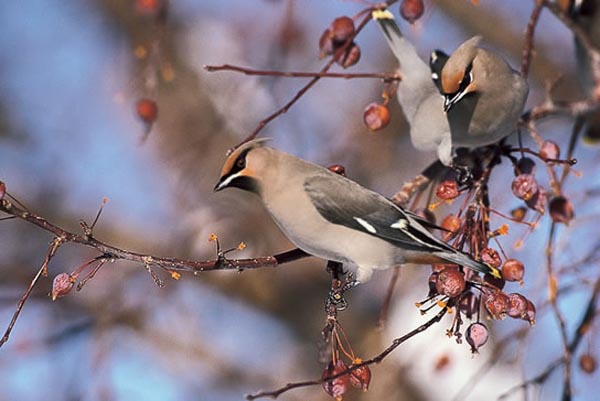Of Fruit and Flowers

These are the dog days of summer…in the southern hemisphere. We need a winter equivalent here to signify these short, cold, and above all, very gray days as the calendar flips from January to February.
One thing that characterizes these mid-winter days for me is that monochromatic tedium of gray: gray branches etched against gray skies. At this point, birds have stripped away the fruit from dogwoods, cedars, hawthorns, and crabapples. Even the fruit of introduced plants such as honeysuckles, buckthorns, and Asiatic bittersweet – so abundant in urban areas – is for the most part long gone.
Just about the only splash of vegetative color is the red hanging clusters of fruit from the highbush cranberry, Viburnum opulus. (The taxonomy is a little tortured – V. opulus is the introduced European shrub, while the native variety is sometimes known as V. trilobum. They’re now usually considered subspecies; in much of the northeast you might find one, the other, or hybrids.) Although it gets picked at occasionally by birds after it ripens in fall, most highbush cranberry fruit isn’t consumed by birds until early spring.
I had always heard the fruit on highbush cranberry remains all winter because it didn’t “taste good” to birds until it had frozen and thawed multiple times. In fact, studies with captive American Robins and Cedar Waxwings determined that they preferred fall fruit in side-by-side trials. Sugars in highbush cranberry fruit do concentrate over the winter due to dehydration, but the chemical composition remains the same, and songbirds, in any case, don’t have much of a sense of taste.
The real reason birds don’t eat highbush cranberry fruit until spring is a little more complicated. The fruits are very acid and low in nitrogen. Birds need a supplemental source of protein to properly metabolize highbush cranberry fruits. In early spring, this protein source is often pollen, in the form of the insignificant-looking flowers of trees like cottonwoods, maples, and oaks.
This is a pretty clever strategy on the part of the Viburnum. In the fall when the fruit ripens, there is a whole smorgasbord of other fruit for birds to choose from. By retaining fruit until spring, highbush cranberry reduces the competition, and hones in on a very efficient seed disperser: the Cedar Waxwing (or in Europe, Bohemian Waxwing). In spring, at a time when many other bird species are beginning to rely on insects for food, waxwings remain mostly dependent on fruit, and highbush cranberry has set the table.
When a flock descends on a patch of highbush cranberry shrubs and goes to town on the fruit, you might also note that they make frequent forays into neighboring trees to partake in a little meal of pollen, completing their dietary requirement. As is their habit, waxwings wipe out a patch of berries and then go on their nomadic way, distributing Viburnum seeds far and wide, just as nature planned it.




Yes! I have noticed them going for the pollen in our slash pines and oaks here in Florida. I have also seen them passng the pollen to each other!